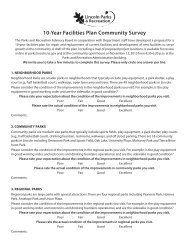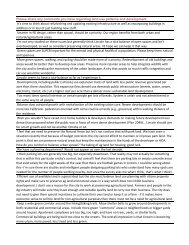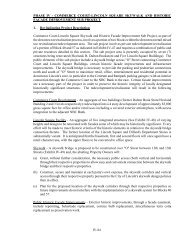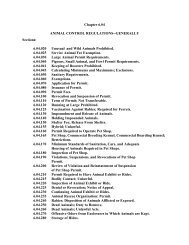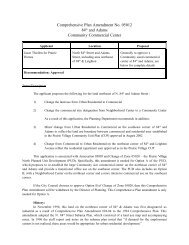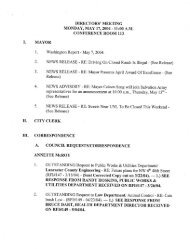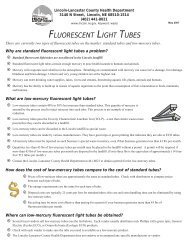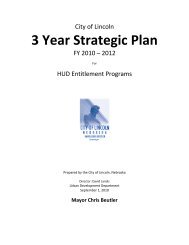Fact Sheet on Cyanuric Acid and Stabilized Chlorine Products
Fact Sheet on Cyanuric Acid and Stabilized Chlorine Products
Fact Sheet on Cyanuric Acid and Stabilized Chlorine Products
You also want an ePaper? Increase the reach of your titles
YUMPU automatically turns print PDFs into web optimized ePapers that Google loves.
<str<strong>on</strong>g>Fact</str<strong>on</strong>g> <str<strong>on</strong>g>Sheet</str<strong>on</strong>g> <strong>on</strong> <strong>Cyanuric</strong> <strong>Acid</strong> <strong>and</strong> <strong>Stabilized</strong> <strong>Chlorine</strong> <strong>Products</strong><br />
What is cyanuric acid? – <strong>Cyanuric</strong> acid is marketed as a chlorine stabilizer for swimming pools.<br />
What does cyanuric acid do? – <strong>Cyanuric</strong> acid forms a weak b<strong>on</strong>d with free chlorine in the pool<br />
water, protecting it from the sun’s ultraviolet rays to reduce chlorine loss. Properly managed,<br />
cyanuric acid has been shown to reduce the amount of chlorine needed to maintain the minimum<br />
chlorine residual in an outdoor pool. In a small pool with a moderate bather load, cyanuric acid<br />
can significantly reduce the cost for chemical disinfecti<strong>on</strong>.<br />
What are dichlor <strong>and</strong> trichlor? – Dichlor <strong>and</strong> trichlor, also known as chlorinated isocyanurates,<br />
are two solid chlorine compounds that are widely used in Lincoln outdoor <strong>and</strong> indoor swimming<br />
pools. Dichlor <strong>and</strong> trichlor c<strong>on</strong>tain both chlorine <strong>and</strong> cyanuric acid so it is not necessary to add<br />
cyanuric acid to the pool water. Dichlor usually comes in a granular form <strong>and</strong> is marketed for the<br />
residential swimming pool market. Trichlor is often sold in a tablet or stick form for use in an<br />
erosi<strong>on</strong> feeder for small commercial pools, such as those at hotels <strong>and</strong> motels.<br />
What is the downside to cyanuric acid? – By forming temporary b<strong>on</strong>ds with the free chlorine,<br />
cyanuric acid will reduce the overall effectiveness of chlorine. The amount of time it takes to kill<br />
bacteria lengthens as the c<strong>on</strong>centrati<strong>on</strong> of cyanuric acid increases. For this reas<strong>on</strong>, the Lincoln-<br />
Lancaster County Health Department recommends that all outdoor pools using cyanuric acid as a<br />
stabilizer maintain a minimum free chlorine residual of at least 2 parts per milli<strong>on</strong> (ppm).<br />
I have an indoor pool. Should I use cyanuric acid? – No. Remember that cyanuric acid is<br />
intended to reduce the loss of free chlorine caused by the sun’s ultraviolet rays. Indoor pools are<br />
not exposed to direct sunlight <strong>and</strong> therefore, there is no benefit in adding cyanuric acid to the<br />
pool water or using products c<strong>on</strong>taining cyanuric acid such as trichlor or dichlor.<br />
How much cyanuric acid should be used in a swimming pool? – Chemical suppliers<br />
recommend that the optimal range for cyanuric acid is 30-50 ppm, although a study published by<br />
1<br />
the University at California at Davis , indicates that there is still significant savings in chemical<br />
costs in levels as low as 2 or 3 ppm. Other authorities recommend about 20 ppm for a good costto-benefit<br />
ratio . At levels above 50 ppm, pools reach the point of diminishing returns where the<br />
2<br />
reducti<strong>on</strong> in chlorine effectiveness <strong>and</strong> cost of buying cyanuric acid outweighs the benefits.<br />
Dichlor by weight c<strong>on</strong>tains 57% cyanuric acid. Trichlor c<strong>on</strong>tains 54% cyanuric acid.<br />
How much is too much cyanuric acid? – The Nebraska Swimming Pool Act has set the<br />
3<br />
maximum level at 100 ppm. A 2007 study by the Centers for Disease C<strong>on</strong>trol <strong>and</strong> Preventi<strong>on</strong><br />
(CDC) revealed that cyanuric acid significantly diminishes chlorine’s ability to inactivate the<br />
chlorine-resistant protozoan, cryptosporidium. Based <strong>on</strong> the findings of the CDC study, the<br />
Lincoln-Lancaster County Health Department recommends that cyanuric acid levels not exceed<br />
30 ppm.<br />
What are the effects of higher levels of cyanuric acid? – As the level of cyanuric acid rises,<br />
free chlorine’s ability to act as a disinfectant is weakened. At above 50 ppm of cyanuric acid, the<br />
time it takes to kill bacteria in the water is l<strong>on</strong>ger compared to swimming pool water without<br />
cyanuric acid. Also, as the level of cyanuric acid builds up, the chlorine will become<br />
increasingly less effective in keeping the water clean <strong>and</strong> problems such as increased cloudiness<br />
<strong>and</strong> exceeding combined chlorine limits can occur.
Should cyanuric acid be used in hot tubs or spas? – At even moderate levels of cyanuric acid,<br />
the amount of time it takes chlorine to kill pseudom<strong>on</strong>as aeruginosa (the bacteria that causes<br />
“hot tub itch”) can be as much as a hundred times as l<strong>on</strong>g as in a hot tub or spa without cyanuric<br />
acid. For this reas<strong>on</strong>, the Lincoln-Lancaster County Health Department does not recommend the<br />
use of cyanuric acid or stabilized chlorine in hot tubs or spas.<br />
How does <strong>on</strong>e test for cyanuric acid? – Any pool operator who uses cyanuric acid or stabilized<br />
chlorine should purchase a test kit capable of measuring cyanuric acid <strong>and</strong> underst<strong>and</strong> how to use<br />
it properly. The best way to manage the problems that come with too much cyanuric acid is to<br />
avoid them. <strong>Cyanuric</strong> acid level should be tested at least <strong>on</strong>ce a week.<br />
My pool has cyanuric acid levels above 30 ppm. How can I reduce them? – Unlike chlorine,<br />
cyanuric acid is never used up <strong>and</strong> accumulates in the pool water as a waste product. Once you<br />
have added it to the pool water, it will remain in the water. The best way to reduce cyanuric acid<br />
is to partially drain the pool <strong>and</strong> add fresh water. Note that some cyanuric acid will cling to the<br />
pool tub, plumbing <strong>and</strong> filtrati<strong>on</strong> system, so even after completely draining <strong>and</strong> refilling the pool,<br />
there will probably be detectable to moderate levels of cyanuric acid in the newly added water.<br />
Summary of Lincoln-Lancaster County Health Recommendati<strong>on</strong>s<br />
1. <strong>Cyanuric</strong> acid <strong>and</strong> stabilized chlorine (dichlor or trichlor) should be used in outdoor<br />
swimming pools <strong>on</strong>ly. It should never be used in indoor swimming pools, spas or hot tubs.<br />
2. Both dichlor <strong>and</strong> trichlor release cyanuric acid to the pool water. It is not necessary to put<br />
additi<strong>on</strong>al cyanuric acid into a pool that uses dichlor or trichlor.<br />
3. Pools that use cyanuric acid should maintain a free chlorine residual of 2 ppm.<br />
4. <strong>Cyanuric</strong> acid should be tested at least <strong>on</strong>ce a week to keep c<strong>on</strong>centrati<strong>on</strong>s below 30 ppm.<br />
5. <strong>Cyanuric</strong> acid levels should never exceed 100 ppm.<br />
6. Partially drain pool <strong>and</strong> add water to reduce cyanuric acid c<strong>on</strong>centrati<strong>on</strong>.<br />
References<br />
1- Williams, Kent. “<strong>Cyanuric</strong>s – Benefit or bomb?”. Professi<strong>on</strong>al Pool Operators of America.<br />
Newcastle, California 1997.<br />
rd<br />
2- Williams, Kent. Aquatic Facility Operator Manual, 3 editi<strong>on</strong>. Nati<strong>on</strong>al Recreati<strong>on</strong> <strong>and</strong> Park<br />
Society 1999.<br />
3- Shields, JM; Arrowwood, MJ; Hill, VR <strong>and</strong> Beach, MJ. (2007 “Inactivati<strong>on</strong> of<br />
Cyrptosporidium parvum under chlorinated recreati<strong>on</strong>al waterc<strong>on</strong>diti<strong>on</strong>s. Journal of Water <strong>and</strong><br />
Health. In press.



